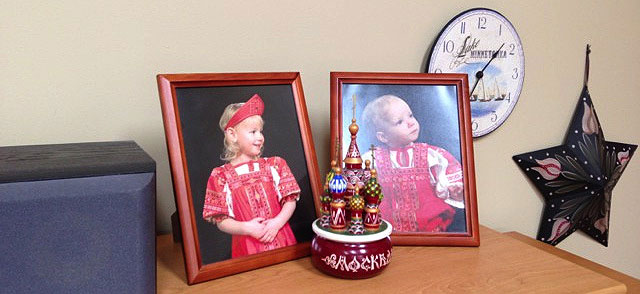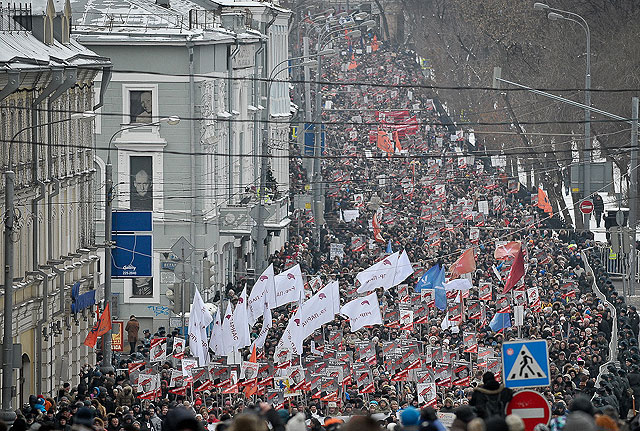On January 1, 2013, the Dima Yakovlev Law came into force in Russia, prohibiting US citizens from adopting Russian children. This legislation was backed by a massive propaganda campaign aimed at discrediting American adoptive families and the United States at large. IMR analyst Olga Khvostunova tried to get to the bottom of the problem and see how Americans really treat their adopted Russian children.

Forgiveness for Dima
Last fall, Pavel Astakhov, Children’s Rights Ombudsman for the president of the Russian Federation, announced that the number of children left without parental custody exceeded 660,000, while the official number of children (defined as younger than 17 years old) in the country was 26 million. In 2011, more than 520,000 children were reportedly in the care of Russian families. Only 7,400 of them have been adopted by Russian citizens, while 3,400 have been adopted internationally. About 100,000 children remained in orphanages. In 2012, Russian families adopted 6,500 Russian children, while foreigners adopted 2,600.
The three countries that adopt the majority of Russian children are the United States (962 children in 2011), Italy (798), and Spain (685). With a substantial lag, they are followed by France (283) and Germany (215). The United States also leads the group in terms of adopting children with special needs: 89 were adopted in 2011 by American families, 30 by Italian families, and 28 by Spanish families.
Overall, in the last 20 years, Americans adopted about 60,000 Russian children. In 2004, that number reached a peak, with 5,862 Russian children being adopted by US families. But from that moment on, the number has been decreasing drastically, dropping to 4,631 in 2005; 2,303 in 2007; and 1,586 in 2009. According to recent data published by the US State Department, in 2012, the number dropped down to 748 children.
During these 20 years, 20 adopted Russian children have died in the US. According to other data, up to 40 deaths may have occurred, including deaths by accident. Without diminishing these tragedies, it is worth saying that objectively, this is a small number. In 2006, Galina Semiya, an advisor to the Moscow Children’s Rights Ombudsman, said that over a period of 15 years, starting from 1991, “1,220 adopted children died; 12 of them were killed by the adoptive parents.” And in April 2010, Pavel Astakhov himself reported at a press conference: “If we compare statistics on the adopted children who died in Russian families and in the US, the bloody countdown will not be in our favor. Every year nine to 15 children die in our adoptive families.” Later, he also said that in 2011, about 8,000 children were removed from their adoptive families because of threats to their lives and health. And Novaya Gazeta has recently compiled and published even more horrifying statistics.
Within the framework of the Russian government propaganda, the tragic deaths of Russian children in the US are presented as a result of the way American parents treat their adopted children.
Still, when at the end of 2012, United Russia lawmakers Yekaterina Lakhova and Olga Batalina initiated the legislation to prohibit the adoption of Russian orphans by US citizens, not only did the Russian children’s ombudsman not object, but he actually became an active promoter of the idea. The law hastily passed by the State Duma was viewed as an “asymmetrical response” to the US Congress’s passage of the Magnitsky Act. It was named after Dima Yakovlev, an adopted Russian child who died as a result of a tragic accident in 2008.
It is important to mention a few key aspects of Dima’s story, since his name was, by a twist of fate, included in the title of the controversial law. His adoptive father, Miles Harrison, left him in the backseat of a car on a day when the outside temperature reached 90°F. The father was sure he had already dropped Dima off at daycare—but he didn’t, and the child died of hyperthermia. Unfortunately, even the most caring parents commit such tragic mistakes, and they are not unheard of in countries with a hot climate. Up to 15 similar cases are reported every year in the United States. The court in these cases often finds the parents not guilty, as happened with Miles Harrison.
In an interview with the Washington Post, Harrison said: “I hurt my wife so much, and by the grace of whatever wonderful quality is within her, she has forgiven me. And that makes me feel even worse. Because I can't forgive me. . . . I pray for forgiveness from the Russian people. There are good people in this country who deserve children, and there are children in Russia who need parents. Please don't punish everyone for my mistake.”
Propaganda Using Kids
Within the framework of the anti-American propaganda that has been circulated by the Russian government, the tragic deaths of Russian children in the United States are presented as a result of the way American parents treat their adopted children. During this campaign, there have been allegations that all adopted children are viewed as human commodities for the United States; that American parents receive substantial financial benefits for taking care of an adopted child; that Americans sedate children using tranquilizers; and that they don’t care about adopted children, beat them, and even kill them.
Considering the sensitivity of the issue, few people are indifferent toward these reports, and therefore, the orphan issue has become an easy but effective tool of political propaganda. The indignation expressed by Kremlin-backed politicians, officials, policy experts, and journalists who make a career out of public criticism of the United States is heard by the Russian public and has an impact on the public mood.

On January 13, more than 50,000 people marched through downtown Moscow in protest against the adoption ban.
For example, in mid-January, the state-owned Russian Public Opinion Research Center reported that 76 percent of Russians supported the Dima Yakovlev Law. Still, polls by the independent Levada Center produce a more complicated picture. According to the published data, only 20 percent of the respondents completely approved of the Dima Yakovlev Law, while 30 percent approved of it partially, and 31 percent either disapproved of it or were “rather against it.” Answering a question about American parents’ motivations, 33 percent responded that they believed that US families adopt children from Russia for humanitarian reasons (because there are more opportunities for development and medical treatment in the United States). The same percentage of respondents were convinced that there are lucrative motivations for American parents to adopt Russian children—that is, they allegedly adopt children to get a variety of benefits that the American government offers to adopting families.
“Adoption Is a Norm”
As Alyona Senkevich, Russian adoption coordinator for the US Hand in Hand agency, said in an interview with the BBC, a large number of US adoptions of Russian children are not caused by the fact that Americans cannot have their own children. Many parents who already have their own children adopt because it’s a norm of American life, a part of the US national culture. Another reason is their religious faith: raising an adopted child is one of the good deeds that Americans think they need to do in life.
Leonid Merzon, an employee of another American agency, Adoptions Together, is of the same opinion. In an interview with Novaya Gazeta, he said: “About a half [of the Americans who adopt Russian children] cannot have their own children; the other half are those who want to adopt a second or a third child. Oftentimes, they are religious people who are trying to do a good deed. But they can also be nonreligious. The majority of Americans have a standard rooted in their minds: family means having two or three children. Hence, they give birth to one or two of their own kids and adopt another one or two. Nowadays, I often read on the Internet: ‘Adopting parents deserve a monument!’ But no one in America sees it that way; adoption there is a norm.”
Both agencies have programs for adopting children with special needs, such as those who lack limbs or have been diagnosed with conditions such as Down syndrome, myelocele (a more serious form of spina bifida), cerebral palsy, brittle bones, and so on. “The majority of children with such diagnoses have no chance to be adopted by Russian parents,” Alyona Senkevich says. “Moreover, if they stay in the system, they end up in special institutions for children with deviations in physical or intellectual development. These institutions have a very tough regimen that to a certain extent reminds me of a prison.”
“In terms of implications, every extra month in an orphanage equals a month spent, say, in Chernobyl.”
“As the world experience has shown, every human being needs an incentive to live,” she continues. “Earlier in life, a mother’s touch can be such an incentive, but later, more complicated psychological incentives appear as well, such as love. Institutionalized children get very little personal communication and thus have very few incentives for physical, emotional, or intellectual development.”
Merzon confirms: “There are no healthy children in orphanages. Their medical charts look frightful. But over the years, I realized that diagnoses . . . usually mean nothing; they are indicated just in case. But 99 percent of the orphans have delays in speech and psychomotor development by the age of three or four. After that, they develop ‘evident delays’ or sometimes oligophrenia. If a child is adopted before he or she is four years old, these development delays can be quickly overcome. At the age of four to eight, it will be more difficult, but still doable. But if a child lived in an orphanage from birth to school age, in 90 percent of cases, the ship has sailed. . . . So kids need to be saved from orphanages as early as possible! In terms of implications, every extra month there equals a month spent . . . say, in Chernobyl.”
Still, Senkevich’s and Merzon’s views on Russian adoption legislation differ. According to Merzon, the search for a new niche where corruption can flourish has been the only motive behind the legislative changes of the last 20 years. “The law-making process started in 1993, when a war between the ministry of education and the regional custodianship agencies broke off. They tried to decide who is to make money on adoptions,” he notes. “For 20 years, various amendments to the regulating laws have been passed at least ten times, and every time in a caddish manner. First, they would announce a moratorium on adoption ‘until the new law is passed,’ then a behind-the scenes struggle would start off, and it could go on for a month, three or six months. . . . Meanwhile, children would suffer in orphanages, adoptive parents would wait and pray, and politicians would deal with the law-making without any rush, until the next law was passed.”
As Alyona Senkevich points out, until recently (when the Dima Yakovlev Law was passed), there had been positive shifts in adoption law. “Today, Russian law has two important provisions,” she says. “First: the prioritized form of children’s arrangement is said to be adoption, not guardianship or foster family, but adoption. Our government has finally realized and formulated this principle as a law: if there is an opportunity for the child to be adopted, it should be done. Second: Russian citizens have a priority right to adopt.” But assessing the adoption ban for US citizens, Senkevich is puzzled: “The moment when the need for international adoption no longer exists is when there are no more Russian orphans who are not adopted by Russian families, [and then] international adoptions will fade away on its own. I just don’t understand why the swords are crossed now.”

